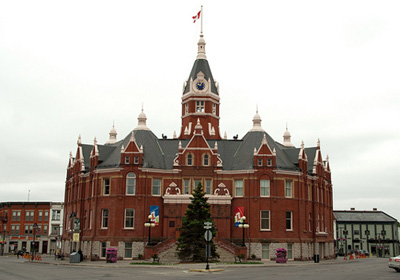Stratford City Hall National Historic Site of Canada
Stratford, Ontario

General view
© Stratford City Hall, Perry Quan, 2011.
Address :
1 Market Square, Stratford, Ontario
Recognition Statute:
Historic Sites and Monuments Act (R.S.C., 1985, c. H-4)
Designation Date:
1976-11-06
Dates:
-
1898 to 1899
(Construction)
Event, Person, Organization:
-
George W. King
(Architect)
-
J.W. Siddall
(Architect)
Other Name(s):
-
Stratford City Hall
(Designation Name)
Research Report Number:
1998-006
Plaque(s)
Existing plaque: 1 Market Square, Stratford, Ontario
Stratford's spacious civic square has been the site of the city's municipal buildings since 1857. Construction began on the present city hall after the destruction of the first town hall and market by fire in 1898. The plans were prepared by prominent Toronto architect, George W. King, assisted locally by J.W. Siddall. The resulting structure is a notable example of a late l9th century public building, monumental in scale and picturesque in aspect. Opened in 1900, it has long been a centre of Stratford's political, social and cultural life.
Description of Historic Place
Stratford City Hall National Historic Site of Canada is prominently located on a triangular-shaped civic ‘square’ that forms the centre of the business district in Stratford, Ontario. Built at the end of the 19th century, it is a monumental town hall constructed of red brick with a prominent clock tower. Its Picturesque design incorporates an eclectic blend of late-Victorian features. The formal recognition consists of the building on its legal property.
Heritage Value
Stratford City Hall was designated a national historic site of Canada in 1976 because: it is significant as a late 19th-century Picturesque civic building.
Stratford City Hall reflects the development of town halls during the late-19th century, as the administrative functions of municipal government increased and cities sought to express their civic pride and ambition in impressive, large-scale buildings. Its Picturesque design, incorporating details from a variety of styles, reflects the architectural eclecticism of the late 1890s. Designed by Toronto architect George W. King, with the assistance of local architect J.W. Siddall, the building was intended to exploit its irregular site, presenting interesting façades from all angles. Its monumental scale, prominent tower and use of red brick distinguish it as a civic building.
Source: Historic Sites and Monuments Board of Canada, Minutes, November 1976, July 1998.
Character-Defining Elements
Key elements which relate to the heritage value of Stratford City Hall include: its siting on an irregular, triangular-shaped site, and its central location; its monumental scale; its plan, intended to exploit its irregular, triangular-shaped site; features typical of late 19th-century town halls, including the prominent clock tower; its late-Victorian eclecticism, evident in the use of features derived from a variety of different styles, including Classical Revival features such as the columns and moulded cornice at the main entrance, Richardsonian Romanesque features including the rounded arch of the main entrance, conical roof structures, and the smaller gables, Dutch Baroque features, including the gable over the main entrance, and Palladian features such as the window on the rear façade; the concentration of exterior detailing at the entrance, the roof and the tower; the gables along the eave line; the use of a variety of materials, colours, shapes and textures, in keeping with the stylistic eclecticism, including red brick walls, rough-dressed limestone foundation, courses of brown sandstone, oak doors, polished marble columns, moulded stone cornices, terra cotta caps and curved decoration, a slate roof and a range of painted wood features; the decorative treatment of all elevations of the building; its use of red-brick, connecting it visually with the nearby Worth Block, and distinguishing it from commercial structures which use the ‘white’ brick common in the region; viewscapes of the building, including its clock tower.